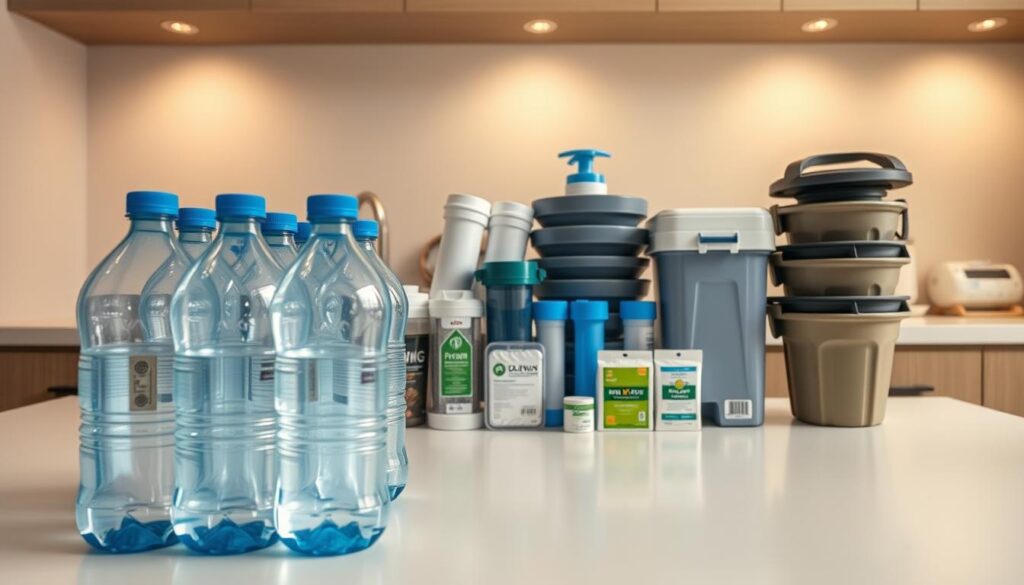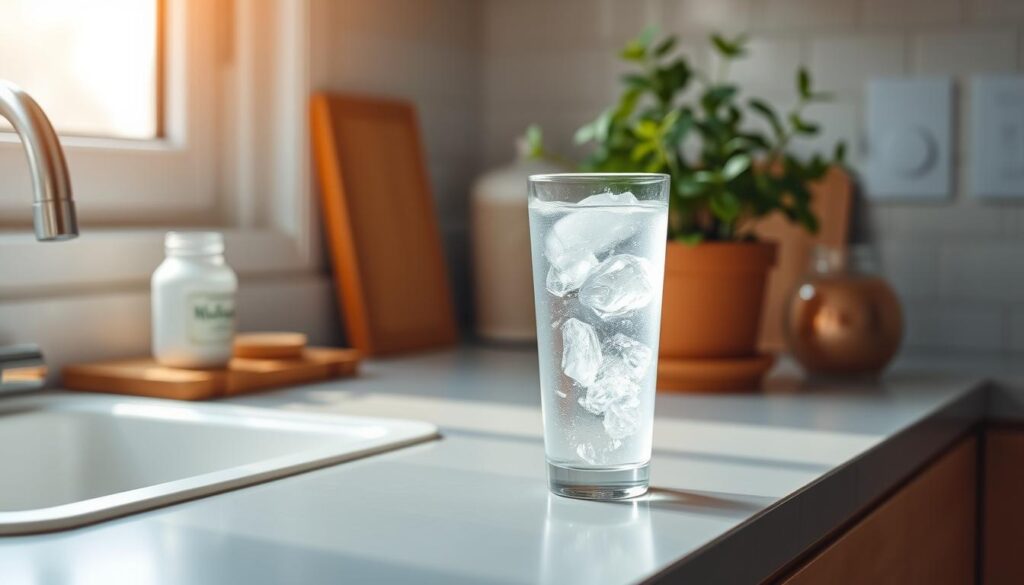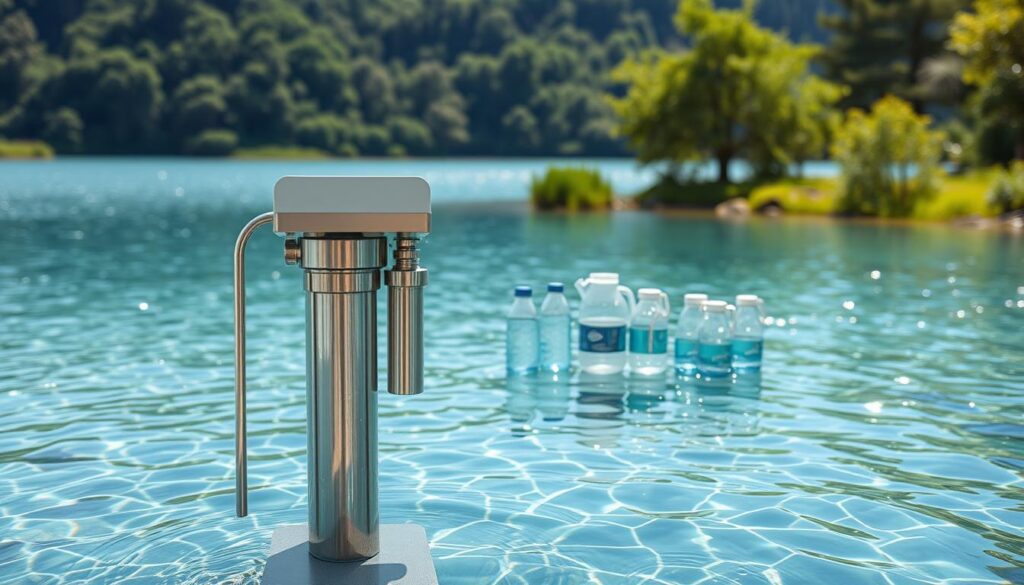Being ready for the unexpected is a mindset I’ve learned over time. Having a solid emergency hydration plan is key to this readiness.
I’ve been through a few natural disasters. I’ve seen how vital a disaster preparedness water kit is. You should aim for at least one gallon of water per person per day for a few days.
This isn’t just about collecting supplies. It’s about keeping my family and me safe during tough times. In this guide, I’ll show you how to build your own emergency water supply kit.
Key Takeaways
- Determine your daily water needs based on the number of people in your household.
- Store at least one gallon of water per person per day for several days.
- Consider the quality and safety of the water storage containers.
- Regularly check and update your emergency water supply kit.
- Include other essential items like food, first aid supplies, and a manual water purification method.
Understanding the Importance of Emergency Water Supply Kits
An emergency water supply kit is key for any home’s disaster plan. When natural disasters or outbreaks happen, having clean drinking water is vital.
Water is very important in emergencies. It’s not just for drinking. It’s also for keeping things clean and healthy. When emergencies hit, having stored water is a must.
Why Water is Essential in Emergencies
Water is vital in emergencies. Our bodies can go weeks without food but only a few days without water. Having enough clean water is key for staying hydrated, cooking, and staying clean.
Water is also key for keeping diseases at bay. After disasters, dirty water can cause sickness. This makes the situation worse.
Types of Emergencies That Require Water Preparedness
Many emergencies need us to be ready with water. Natural disasters like hurricanes, earthquakes, and floods can cut off our water supply.
- Natural disasters (hurricanes, earthquakes, floods)
- Outbreaks and pandemics
- Man-made disasters (industrial accidents, terrorist attacks)
Having an emergency water kit can help a lot during these times.
Personal Stories of Water Shortages
Many people and communities have faced big water shortages in emergencies. For example, Hurricane Katrina left many in New Orleans without clean water.
| Emergency Type | Impact on Water Supply | Consequence |
|---|---|---|
| Hurricanes | Flooding and infrastructure damage | Contamination of water sources |
| Earthquakes | Damage to water treatment plants and pipes | Loss of access to clean water |
| Outbreaks | Contamination of water sources | Spread of waterborne diseases |
These stories show why having a good emergency water supply kit is so important. Being prepared can greatly reduce risks from water shortages in emergencies.
Assessing Your Water Needs
Knowing how much water you need is key to a good disaster preparedness water kit. When emergencies happen, having enough water is essential for staying alive.
Calculating Daily Water Requirements
It’s wise to store at least one gallon of water per person per day for a few days. This water is for drinking, cooking, and staying clean. To figure out your daily needs, think about these points:
- Drinking water: at least one gallon per person per day
- Cooking and food preparation: add 0.5-1 gallon per person per day
- Personal hygiene: 0.5-1 gallon per person per day
For example, a family of four needs at least 4 gallons of water per day just for drinking. Adding water for cooking and hygiene, the total needed could be over 8 gallons.
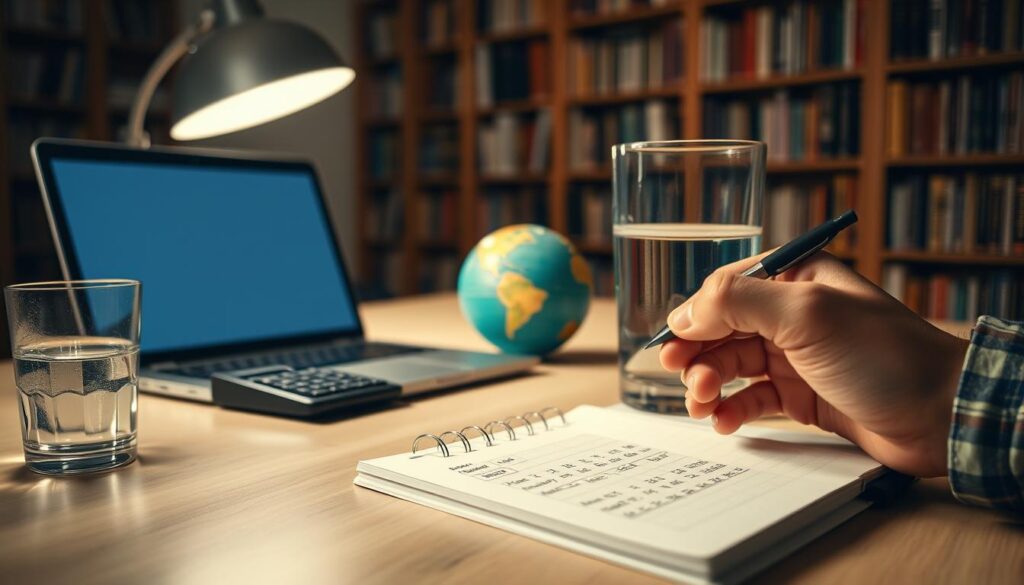
Accounting for Family Size and Pets
Remember to include your family and pets when figuring out your water needs. Each person and pet needs a certain amount of water every day.
| Family Member | Daily Water Requirement |
|---|---|
| Adult | 1 gallon |
| Child | 0.5 gallon |
| Pet (dog/cat) | 0.25-0.5 gallon |
Factors to Consider During an Emergency
In an emergency, your water needs might go up because of things like the weather, how active you are, and the type of emergency. For example:
- Hot weather: you’ll need more water to stay hydrated
- Physical activity: you’ll need more water to stay hydrated
- Illness: you might need more water for medical reasons
By thinking about these factors, you can make sure you have enough water for emergencies.
Choosing the Right Container for Water Storage
Choosing the right container for water storage is key when building an emergency water supply kit. The container you pick affects the water’s quality and safety.
Look for a container that’s durable, non-toxic, and good for long-term storage. Experts say using FDA-approved food-grade containers is best.
Best Materials for Water Containers
The container’s material is key for keeping water quality high. Food-grade plastic and stainless steel are top choices. Food-grade plastic is light and doesn’t corrode, while stainless steel is strong and can handle extreme temperatures.
Avoid containers that can leach chemicals into the water. This includes some plastics and containers that held chemicals.
Sizes and Shapes That Work
Water containers come in many sizes and shapes. The size you pick depends on how much water you need and where you can store it. Sizes range from a few gallons to over 55 gallons.
Think about how many people you’re planning to support and how long you need to store water. Aim for at least one gallon per person per day for drinking, cooking, and hygiene.
| Container Size (Gallons) | Number of People | Duration (Days) |
|---|---|---|
| 1-5 | 1-2 | 1-5 |
| 10-20 | 2-4 | 5-10 |
| 30-55 | 4-6 | 10-14 |
How to Store Containers Safely
After picking the right containers, store them safely to keep the water quality good. Keep them in a cool, dark place, away from sunlight and contamination sources.
Store containers off the floor to avoid damage from flooding or pests. Check your containers often for damage or wear and tear. Replace them if needed.
Sources of Emergency Water
Finding the right sources of emergency water is key to being prepared. In an emergency, having clean drinking water is vital. Knowing where to find it can be a big help.
Tap Water and Well Water Storage
Tap water or well water is a good source of emergency water, if treated and stored right. It’s important to use food-grade containers that are clean and sanitized to avoid contamination. Storing tap or well water safely is also critical to keep it clean.
- Use containers made for water storage.
- Keep containers away from sunlight and contamination sources.
- Label containers with the storage date.
Store-Bought Water Bottles
Store-bought water bottles are a reliable choice for emergency water. Unopened, commercially bottled water is the safest and most reliable because it meets strict quality standards. Make sure the bottles are sealed and not damaged when you buy them.
Store-bought water bottles have several benefits:
- They are easy to find for purchase.
- They last a long time if stored correctly.
- They are already treated and safe to drink.
Rainwater Harvesting Techniques
Rainwater harvesting is a green way to collect and store rainwater for emergencies. It involves directing rainwater from rooftops or surfaces into tanks. Proper filtration and treatment are needed to make the rainwater safe for drinking.
Effective rainwater harvesting techniques include:
- Using a first flush device to remove roof debris.
- Implementing a filtration system to remove particles.
- Treating the rainwater with disinfection methods.
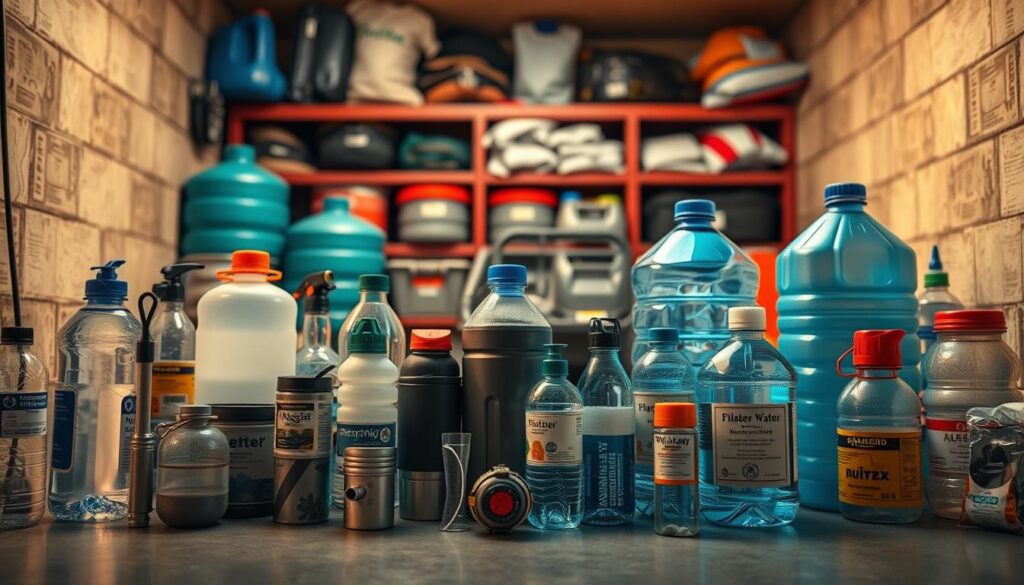
Water Purification Methods
Having a way to make water safe is key in emergencies. Natural disasters or crises make it vital to know how to purify water. The right tools and knowledge can save lives.
Boiling Water: The Basics
Boiling water is a simple yet effective way to purify it. Boiling water kills bacteria, viruses, and other pathogens that can make you sick. To boil water, heat it until it rolls and boils for at least one minute. This method works well but needs a heat source and takes time.
Using Water Filters and Purification Tablets
Water filters and purification tablets are great for convenience and portability. Filters remove particles and some germs, while tablets kill bacteria and viruses. For tips on using water filters, check out this guide on emergency filtration. Choose between filters and tablets based on the contamination level and ease of use.
Chemical Treatments for Water Safety
Chemical treatments, like chlorine or iodine tablets, are another good option. These chemicals disinfect the water by killing harmful microorganisms. But, it’s important to use the right amount and wait the right time as the maker says. Some people might be allergic to these chemicals, so be careful.
Knowing how to purify water can greatly lower the risk of getting sick from it in emergencies.
Assembling Your Emergency Water Supply Kit
Building an emergency water supply kit is key to being ready for disasters. It ensures you have clean water for your family during emergencies. This kit is your lifeline, providing the hydration you need to survive.

Key Components to Include
When creating your disaster preparedness water kits, focus on a few important items. First, store enough water for each family member. Aim for at least one gallon per person per day for drinking, cooking, and hygiene. For more on disaster kits, check out Ready.gov.
Also, include emergency hydration supplies like water purification tablets or a filter. These ensure safe water use, reducing illness risks.
Extra Supplies for Long-Term Storage
For longer storage, add extra items to your kit. Include non-perishable food, a first aid kit, and a communication device. A manual water purification system is also wise, for safe water use.
Choose the right container and storage for your water. Use food-grade containers that are clean and sanitized. Store in a cool, dark place, away from contamination sources.
Packing and Organization Tips
When packing your emergency water supply kit, focus on organization and easy access. Store it in a designated area, like a basement or storage room. Make sure everyone knows where it is.
Use a checklist to confirm all necessary supplies are included. Regularly check your kit to ensure everything is usable and not expired. These steps help create a complete emergency water supply kit, keeping your family safe in disasters.
Storing Your Emergency Water Supply
Storing emergency water needs careful thought. This ensures the water stays safe and ready to use.
Choosing the Right Location
Where you store your emergency water is key. Look for a cool, dry spot, away from sunlight and harmful substances. Basements or dark, cool places are best.
Make sure the area won’t flood and is not near chemicals or fuel. It should also be easy for everyone in your family to reach.
Temperature and Light Considerations
Temperature and light can harm your stored water. High heat can grow algae and bacteria. Sunlight can cause chemical reactions in the water or containers.
Keep water in a spot with a steady temperature between 50°F and 70°F (10°C and 21°C). Don’t store it near windows or in sunny areas.
Regular Maintenance of Your Water Supply
Regular upkeep is vital for your emergency water’s safety. It’s best to change the water every six months to keep it fresh.
Regularly check your containers for damage, leaks, or contamination. Also, look for any signs of water spoilage or contamination.
- Check containers for damage or leakage.
- Inspect water for visible signs of contamination.
- Replace water every six months.
By following these tips, your emergency water will always be ready and safe to drink.
Preparing for Specific Scenarios
Different emergencies need different plans, and having water ready is key. When we talk about emergency water kits, we must think about the challenges each situation brings.
Natural Disasters and Their Unique Challenges
Natural disasters like hurricanes, earthquakes, and floods need special water plans. For example, hurricanes can make water unsafe, so having a way to clean water is critical. The Red Cross says it’s important to have a plan for safe water.
Earthquakes require strong, safe water storage. This might mean using containers made to handle earthquakes.
Urban vs. Rural Considerations
Urban and rural areas face different water challenges. In cities, finding water can be hard due to crowded or damaged areas. Rural areas often struggle with getting to water sources because they are far away.
City folks should know where to find water, like fire hydrants. Rural people need to make their own water systems.
“The key to survival in any emergency is preparation. Having a well-thought-out plan for water supply can make all the difference.”
Traveling with Emergency Water Supplies
Travelers need to pack water supplies wisely. Choose containers that are light, safe, and can handle different conditions.
- Opt for lightweight, BPA-free containers that can withstand various environmental conditions.
- Consider using hydration packs or collapsible water containers for ease of transport.
- Always check the local regulations regarding the transportation of water supplies.
Being ready for different situations helps keep us safe. It also helps our communities stay strong during emergencies.
Educating Your Family on Water Preparedness
Getting your family involved in water preparedness is key to being ready for emergencies. It’s not just about having water on hand. It’s also about making sure everyone knows what to do in an emergency.
Involving Kids in Emergency Planning
Teaching kids about water preparedness can be fun and educational. By letting them help plan, they learn why emergency water supply kits are important. You can even make it a game to test their knowledge.
It’s a chance to teach them about water safety and how to purify water.
Establishing a Water Use Plan
Having disaster preparedness water kits is just the start. You also need a plan for using this water. This means figuring out how to share it among family members.
For example, you’ll need to decide how much water each person gets for drinking, cooking, and staying clean. A simple plan could be to give each person a certain amount of water each day for these needs.
| Activity | Water Allocation (liters per person per day) |
|---|---|
| Drinking | 2 |
| Cooking | 1 |
| Hygiene | 1 |
Practicing Water Rationing Techniques
Practicing water rationing techniques helps your family use water wisely in emergencies. This means turning off taps when not in use and using water-efficient cleaning methods.
By doing this regularly, your family will use water more mindfully. They’ll be better prepared for emergencies.
Regularly Reviewing and Updating Your Kit
Keeping your emergency water supply kit in good shape is key. I suggest checking it often to make sure it’s ready when disaster strikes.
Checking Water Quality
Look out for signs that your water might be bad. This includes visible dirt, strange smells, or tastes. Catching these problems early can save you a lot of trouble.
Expiration Dates and Storage
Don’t forget to check the expiration dates on your water and purification tablets. Storing them right, like in a cool, dark spot, can make them last longer.
For the latest tips on getting ready for emergencies, follow trusted sources. The American Red Cross and local emergency teams are great places to start.
FAQ
What is the recommended amount of water to store for emergency purposes?
Store at least one gallon of water per person per day. This is for drinking, cooking, and hygiene. Aim for a three-day supply minimum.
What types of containers are best for storing emergency water supplies?
Use containers made from food-grade materials like BPA-free plastic or glass. Choose durable, airtight containers designed for water storage. Brands like Reliance Products or WaterBrick are good options.
How often should I check and maintain my emergency water supply?
Check your emergency water supply every six months. Make sure the water is safe to drink and the containers are in good shape. Rotate your stock every six to twelve months.
What are some effective methods for purifying water during an emergency?
Boiling water is simple and effective. Water filters like LifeStraw or purification tablets like Potable Aqua also work well. Sometimes, chemical treatments like chlorine or iodine can be used too.
Can I use rainwater harvesting as a source of emergency water?
Rainwater harvesting can be a good option. But, make sure the collection system is designed and maintained to prevent contamination. Treat or purify the water before drinking it.
How do I involve my kids in emergency water preparedness planning?
Teach kids about water conservation and preparedness. Involve them in planning, like storing water or learning about purification methods. This helps them feel more in control and prepared.
What are some key considerations when storing emergency water supplies in different environments?
Consider temperature, light, and humidity when storing water. Store it in a cool, dark place, away from contamination sources. Be aware of challenges in urban or rural areas.
How can I stay informed about the latest emergency preparedness guidelines?
Follow reputable sources like the American Red Cross, FEMA, and CDC. Regularly review and update your emergency water supply kit to keep it effective and relevant.
What are some signs that my emergency water supply needs to be replaced?
Look for visible contamination, sediment, or algae growth. Check for expired or damaged containers. Replace the water if you notice unusual odors, tastes, or colors.
Can I use tap water as a source of emergency water supply?
Tap water can be a good option. But, make sure it’s properly treated and stored. Be aware of any contaminants or issues with the municipal water supply.
What are some portable water filtration systems that I can consider for emergency water supply?
Consider portable systems like Sawyer Mini or MSR TrailShot. They can remove contaminants and bacteria, making water safe to drink in emergencies.

